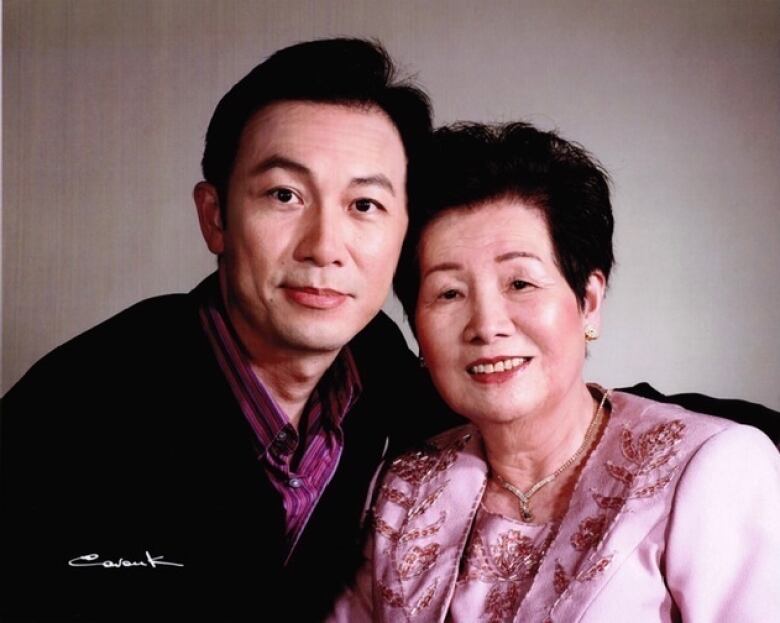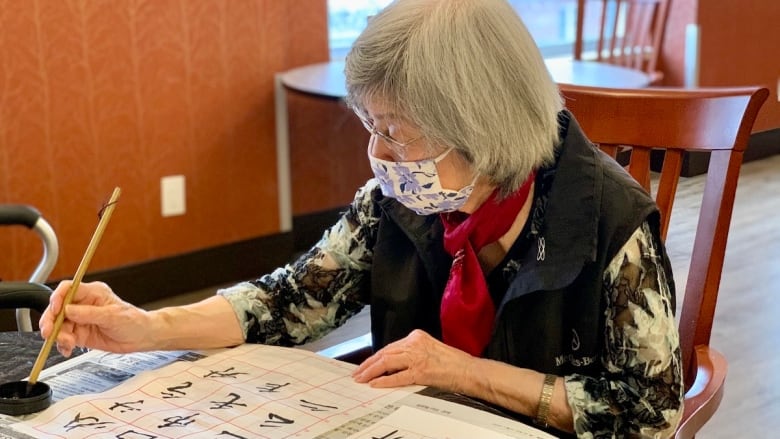Lily Wong was admitted to the Yee Hong Centre for Geriatric Care in Toronto at age 88, several years after she had a stroke that severely affected her short-term memory, ability to follow conversations and her balance.
The wait time to get into the long-term care home was nine to 10 years, but Wong was admitted in slightly less than seven.
"Which was, like, super fast," said her son, Tony Wong.
It's been two years since she was admitted, and Lily Wong is doing well living in a home that meets her cultural needs, her son said. It's a relief to her children, too.
"If you can go into a nursing home environment that speaks your language, that has culturally specific activities, that has food you remember, it's just a massive weight off," said Tony Wong.
"It's just an incredible thing to be able to experience."

Part of the reason for the long wait time is because Yee Hong Centre for Geriatric Care is one of few culturally specific homes that cater to the Chinese-Canadian community in Toronto and the surrounding areas.
Experts say culturally specific care homes have some of the lengthiest wait times for long-term care. A study by the Wellesley Institute, a non-profit that works in health research and policy, found that more than half of the top 20 homes in the Greater Toronto Area with the longest wait times are culturally specific care homes, reflecting a need for more of such facilities.
"Demographic changes have [driven] the increasing demand for such care," said Seong-gee Um, a researcher at the Wellesley Institute.
"It's really crucial for the system to adapt and evolve and reflect the diversity of its current and future residents."
Longer waits
What's more, in 2017/2018, those wanting to live in culturally specific care homes had to wait an average of 246 days longer than those waiting for a mainstream home, even when they had the same level of needs.
Those longer wait times can have health implications for older adults awaiting long-term care.
"We do know that there [are] differential health outcomes for folks who are from diverse communities," said Ashley Flanagan, a research fellow whose work focuses on gender identity and aging at the National Institute on Ageing, a think-tank on growing older in Canada.
"Whether it's waitlists to access a culturally appropriate home, [that] tends to take longer to be admitted. Therefore you see declining health and not [being] able to access care."

Stella Lang, a senior administrator at Mon Sheong Long-Term Care Centre, which has four locations throughout the Greater Toronto Area, said something as simple as the language spoken by those looking after residents is important.
Having health-care providers and staff who can serve patients in Mandarin or Cantonese is significant for residents who may have lost the ability to speak English in their old age, a common scenario for residents with dementia, said Lang.
Staff can even help translate for residents whose first language is Chinese and family members who may be second-generation Canadian and therefore understand English better.
"That's why they don't feel that isolated, and they don't get too much depression," said Lang.
While the appreciation for culturally specific homes is evident, there are not enough to meet the level of demand across the province, according to Ontario's Long-Term Care COVID-19 Commission final report, which calls for more culturally specific homes to meet the needs of Ontario's diverse population.
'Developed by the communities'
Culturally specific homes generally offer a high standard of care, in part because of their funding structure and community support, according to AdvantAge Ontario, an advocacy group dedicated to advancing senior care.
"They're developed by the communities, for the community," said Lisa Levin, the group's CEO.
Community integration is integral to their structure because that's how most of them were founded. What's more, the boards that run the culturally specific homes are representative of the community for whom they provide care.
"So that means that the philosophy of care, the approach to care, the language of care … the food, the traditions, the celebrations, the volunteers, they're all culturally appropriate," said Levin.

Culturally specific care homes also tend to be not-for-profit, which advocates for the elderly believe plays a big role in the health and well-being of residents because of how they are operated.
All long-term care homes in Ontario get the same funding formula from the province, which provides enough for 2.75 hours of direct care per resident per day.
Culturally specific care homes and municipally funded homes tend to subsidize the care further, said Dr. Samir Sinha, director of geriatrics at Sinai Health, an academic health science centre in Toronto.
"Often they will do fundraising, they'll have galas, do bake sales, they'll do a whole bunch of fundraising efforts where the community invests additional dollars to create nicer facilities beyond what the government will fund," said Sinha.
In addition to government funding, AdvantAge Ontario reports that not-for-profit and municipal care homes annually contribute more than $300 million in extra funding in Ontario alone. That additional money goes to paying staff better wages and to the facilities themselves, which contributes to a higher standard of care, according to AdvantAge.
High demand but short supply
While there is little data that specifically looks at the health of seniors placed in culturally appropriate care, both staff and children of residents at Mon Sheong Long-Term Care Centre and Yee Hong Centre for Geriatric Care support the notion that seniors do better when they receive it.
For example, at Mon Sheong Long-Term Care Centre, residents are served familiar dishes such as congee for breakfast. Since they enjoy the food, they're more likely to eat it, which allows for better nutrition, improving overall health, Lang said.
Despite the overall psychosocial and physical benefits, significant disparities exist regarding access and wait times.

According to a Wellesley Institute study, wait times can vary depending on factors such as an individual's health status or the urgency of long-term care admission. However, wait times are particularly long for those seeking placement in a religious, ethnic or cultural home.
That same study found that homes serving Chinese-Canadians had longer average wait times than other groups, at two to seven years.
Some family caregivers may hold off placing loved ones in long-term care due to the lack of culturally appropriate options.
A study in the Journal of the American Medical Directors Association showed that older adults from diverse backgrounds are underrepresented in Canadian long-term care resident populations. The study said that immigrants who arrived in Canada after 1985 make up only 4.4 per cent of long-term care residents in Ontario even though they comprise 13.9 per cent of the total population.
While culturally specific care homes have proven popular, there are some cultural groups that are too small or not mobilized enough to start their own homes.
Generally, those communities are newer to Canada or lack the critical mass or the fundraising power.
"When you have an Ismaili person, a Somali person, an Afghani person who needs culturally safe and appropriate care, there isn't a specific home that caters to the needs of those communities," said Sinha.
The way forward
The solution to removing barriers to culturally safe and appropriate care may be found in data.
A recent study that looked at enhancing data collection in long-term care settings in Canada called for the government to collect a standardized set of sociodemographic information, including age, sex assigned at birth, gender identity, sexual orientation, race, ethnicity, language and Indigenous identity — something that many other countries, including the U.K., Australia and the U.S., already do.
"I think if we were to kind of take up this mandate and advocate for better sociodemographic data collection, we get a better sense of who's accessing and who isn't, and that will give us a sense of where to start directing policy and implementing measures," said Flanagan.
Long waits for Toronto-area nursing homes geared to cultural groups reflect need for more of them, report says - CBC.ca
Read More

No comments:
Post a Comment